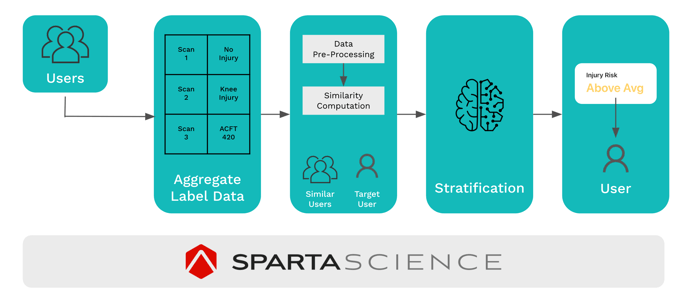Risk is a machine-learning derived value assigned to an individual based on the results of their most recent Jump Scan leveraging our continuously growing data and insights.
Risk is a representation of an individual’s relative risk of suffering a musculoskeletal injury compared to their peers.
Read more about risk modeling in our white paper: Injury Risk: Is it predictable?
How does the scale work?
Risk is a categorical metric based on a trained machine-learning model, with five unique risk values on a scale: Low, Below Average, Average, Above Average, and High. As Risk ranges from one value to another (e.g., Low to Below Avg), the relative change or increase in relative risk can be interpreted as approximately 20%. Average risk can be considered an average or typical risk for our database, with the two values on either side being interpreted as risk greater than (Above Avg, High) or less than (Below Avg, Low) average.
How was the model developed?
Sparta Science has been consistently aggregating ground reaction force data from numerous assessments along with securely shared injury (and other relevant human observational) data into our data platform for over a decade from 80k+ unique individuals across all ranges of age and ability. With this depth of data, Sparta Science can develop and deploy iteratively updated machine-learning models that can be run in real-time. The capabilities of the Movement Health Platform allow for a variety of different types of models to be developed, including models intended to stratify risk.

The base out-of-the-box Risk model (base athletic population) in our platform is iteratively updated by leveraging our accumulating data lake of force plate assessment data and securely shared injury data provided by our partners, primarily in high school, collegiate, and professional sports.
Supported by our data scientist, machine-learning engineers, and subject matter experts, the platform’s calculation engine is able to analyze a user’s kinetic (force plate) data and compares this data to anonymized aggregate kinetic, injury, exposure, and assigned sex information to assign a Risk value for each individual. This model has shown significant predictive accuracy in athletic populations, while the results of the Risk metric for novel populations should be interpreted with caution.
Future iterations and population-specific models are in development and, given sufficient data, can be developed and deployed for specific use cases and/or customer organizations.
What goes into generating Risk?
The current input features that contribute to the model are listed below.
- Assigned Sex at Birth
- Load (Average Eccentric Rate of Force)
- Explode (Average Relative Concentric Force)
- Drive (Relative Concentric Impulse)
- Mass
- Jump Height
What's next?
Risk-specific (e.g., overuse injury) and population-specific (e.g., Basic Military Trainee) models are currently in research and development stages. With any modeling efforts, sufficient data needs to be ingested for model development, and model accuracy needs to be evaluated before deployment.
Customer organizations utilizing Sparta Science’s Movement Health Platform work collaboratively with their Customer Success Manager and our Data Science team to further perform analyses (e.g., correlation, metric extraction, classification and regression, clustering, etc.) and model development specific to their implementation and goals. These models can be deployed in real-time to customer applications to support decision-making and provide insights.
